I’ve written about alcohol for almost 20 years, and in that time, I’ve learned a few things. One of the biggest things I’ve learned is that there’s something special about whisk(e)y. Whether you enjoy a nuanced single malt Scotch whisky, a complex bourbon whiskey, a spicy rye whiskey, or any random whisk(e)y (only the U.S., Ireland, and Mexico use the ‘e’ in whiskey) from a far-flung locale, this barrel-aged spirit is for everyone.
There are countless styles and expressions to choose from, and there are a number of ways to imbibe them. This includes cracking a bottle open, pouring it into a glass, and drinking it neat. You can also sip it on the rocks with a splash of water to open up the aromas and flavor, or enjoy it mixed into your favorite whiskey-based cocktail. We aren’t here to tell you how to drink whiskey. But we would love to help guide you on your boozy journey.
To help you start your whiskey adventure, we turned to Tommy Tardie, world-renowned whiskey connoisseur and the owner of The Flatiron Room. He was gracious enough to help clarify some whiskey questions and guide us through the ins and outs of how to drink whiskey.
What is whiskey?
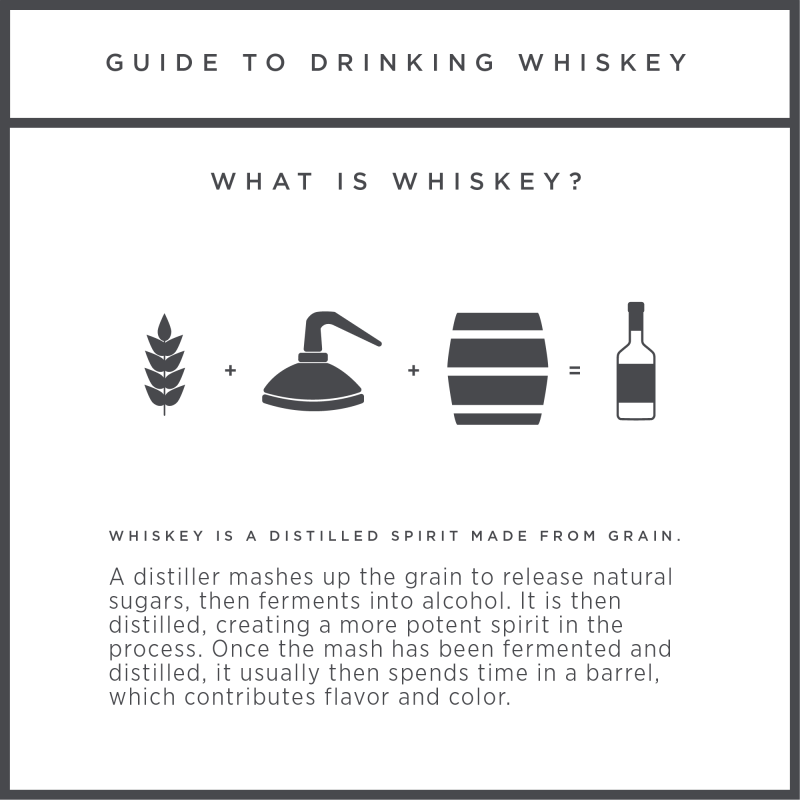
If you’re a frequent visitor to The Manual, then you probably don’t need an introduction to whiskey. In fact, there’s a decent chance you’re nursing a tumbler at this very moment. Still, learning more about the wide world of whiskey can help boost your enjoyment. Tardie embarked on an international mission to learn everything he could about whiskey before opening The Flatiron Room. Before we get to Tardie, though, let’s break down what whiskey actually is (for those who don’t know or aren’t sure of all the specifics).
In short, whiskey is a distilled spirit made from grain. To get to the distillation point, a distiller mashes up the grain to release natural sugars, which are then fermented into alcohol. That alcohol is then distilled, creating a more potent spirit in the process. The grain that’s used can vary, but more often than not, you’ll find whiskies made with corn, rye, wheat, and barley (both malted and not). Other grains, such as millet and quinoa, are used on occasion, but the four we just mentioned are the major players. Once the mash has been fermented and distilled, it usually spends time in a barrel, which contributes flavor and color.
And voila! Whiskey in a nutshell. Now, onto the man who has taken the New York City whiskey world by storm, Tommy Tardie.
“The great things about whiskey are that it is so diverse and can appeal to a very broad range of palates,” said Tardie. “Bourbon, rye, single malts, blends — they’re all whiskey.” (If you’re curious about the different spellings of “whiskey,” here’s a quick breakdown of the difference.)
If there’s a theme to this guide, it’s “exploration.” There’s no one right way to drink all whiskeys — instead, enjoying whiskey is a personal journey that could easily change from week to week, day to day, drink to drink. The protocol outlined in this guide of how to drink whiskey works well with any whiskey under the golden sun. We’ll take you through the basics, but ultimately, you have to follow your own palate.
How to drink whiskey

Enjoying whiskey straight or neat
The next time you have a glass of whiskey, resist the urge to toss ice into it immediately. You’ll find that many whiskeys are greatly enhanced by ice, but you’d be doing yourself a disservice if you didn’t at least try the whiskey neat.
“Before I got into the hospitality game, I would usually order a whiskey neat when I went out,” Tardie told us, recommending neat whiskey for those who enjoy the taste of alcohol. “I would refer to my whiskey as a single-ingredient cocktail.”
If you find that you don’t like your whiskey neat, that’s totally fine. With the high alcohol content (approximately 40% to 43% alcohol by volume) and bold flavor profiles, a glass of straight whiskey can be like a slap in the face to your taste buds. In order to get more of a warm hug experience, why not add a little water?
Why you can add water to whiskey
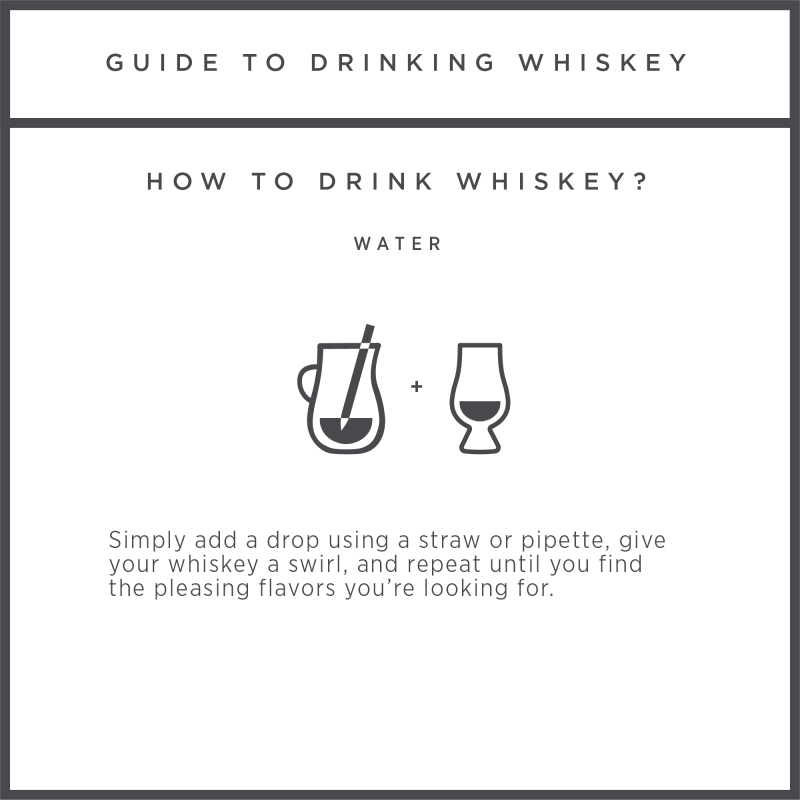
If you’re new to the world of whiskey, you might roll your eyes at the prospect of adding a few drops of water. How could a drop of water make a difference?
“A splash of water can be a great thing,” Tardie explained. “A little water releases the hydrophobic (water repellent) elements in the glass, allowing you to detect more aromatics on the nose and, by lowering the alcohol content, it can allow you to taste more flavors on your palate.”
The easiest way to go about this is with a glass of water and a straw. Simply add a drop, give your whiskey a swirl, take a sip, and repeat until you find the pleasing flavors you’re looking for. The bigger the splash, the more diluted your whiskey will become, achieving the effect of ice without chilling the refreshment.
Should you get whiskey on the rocks?
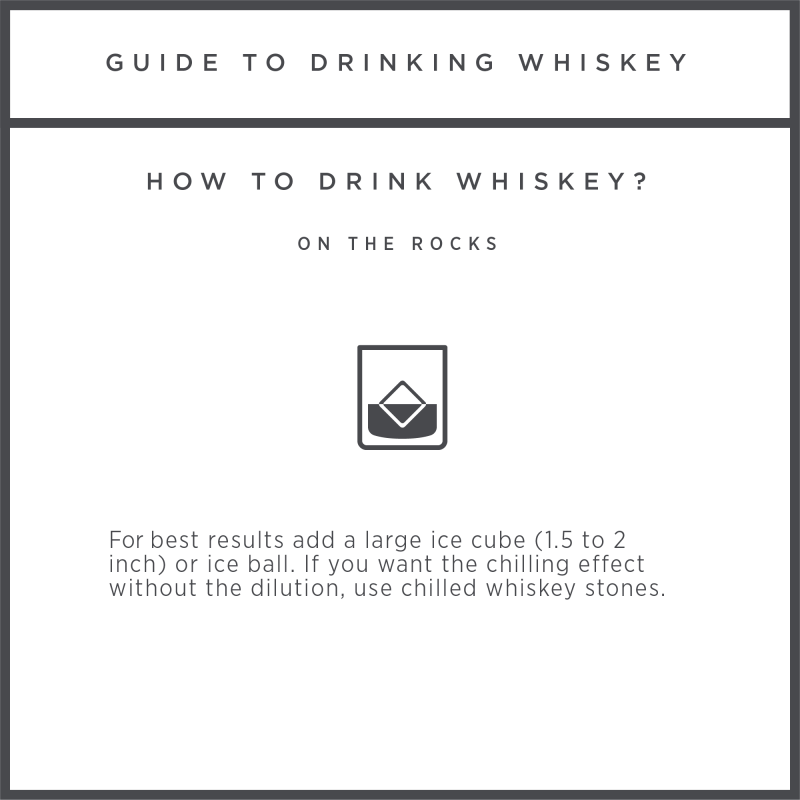
Ordering a whiskey “on the rocks” may sound cool, but it may not necessarily be what you want. “Ice actually numbs your palate and dulls the flavors,” Tardie lamented. “But hey, sometimes you just want a cold glass of whiskey — I say go for it.”
As for the type of ice, you’re best off going with a large ice cube (1.5 to 2 inches) or ice ball. Small cubes or chunks of ice will melt faster than larger pieces, diluting your whiskey more quickly. If you want the chilling effect without the dilution, you might consider adding chilled whiskey stones.
Whiskey cocktails
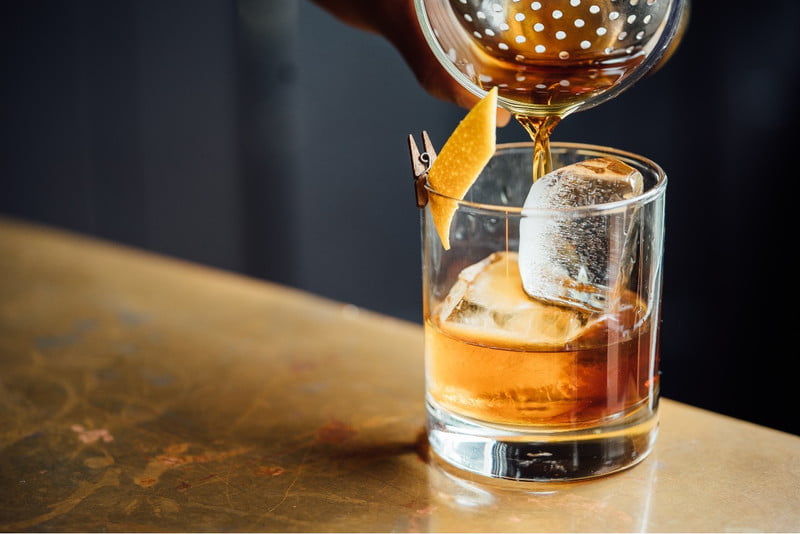
If you don’t like the taste of whiskey by itself, or if you’re looking for a new way to enjoy whiskey, we urge you to try it in a classic cocktail. Tardie recommends rye whiskey bases due to their assertiveness and ability to hold their own in a mix.
Had your fill of the classics? Try out simple twists on time-tested recipes, especially ones where you wouldn’t expect whiskey. “Because the profile of whiskey is so diverse, you can have a lot of fun experimenting with the various flavors,” Tardie said, whose only experimental kryptonite is frozen water. “We offer a unique twist on the Bloody Mary, but we substitute vodka with Ardbeg, a heavily seated single malt from Islay,” Tardie continued.
Whiskey sour
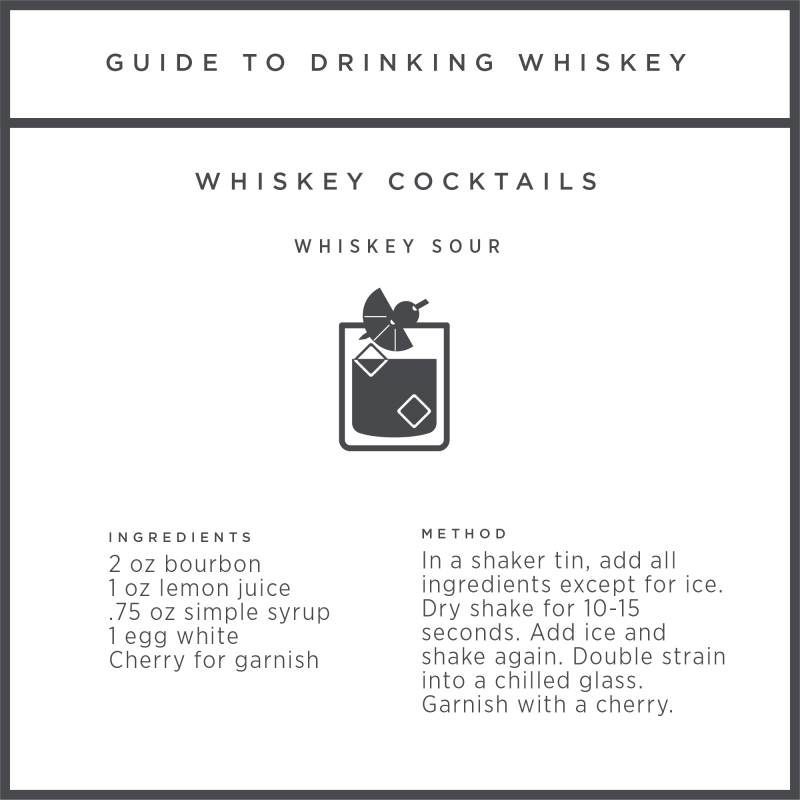
Ingredients
- 2 ounces bourbon
- 1 ounce lemon juice
- 3/4 ounce simple syrup
- 1 egg white
- Cherry for garnish
Method
- In a shaker tin, add all ingredients except for ice.
- Dry shake for 10-15 seconds. Add ice and shake again.
- Double strain into a chilled glass and garnish with a cherry.
Manhattan
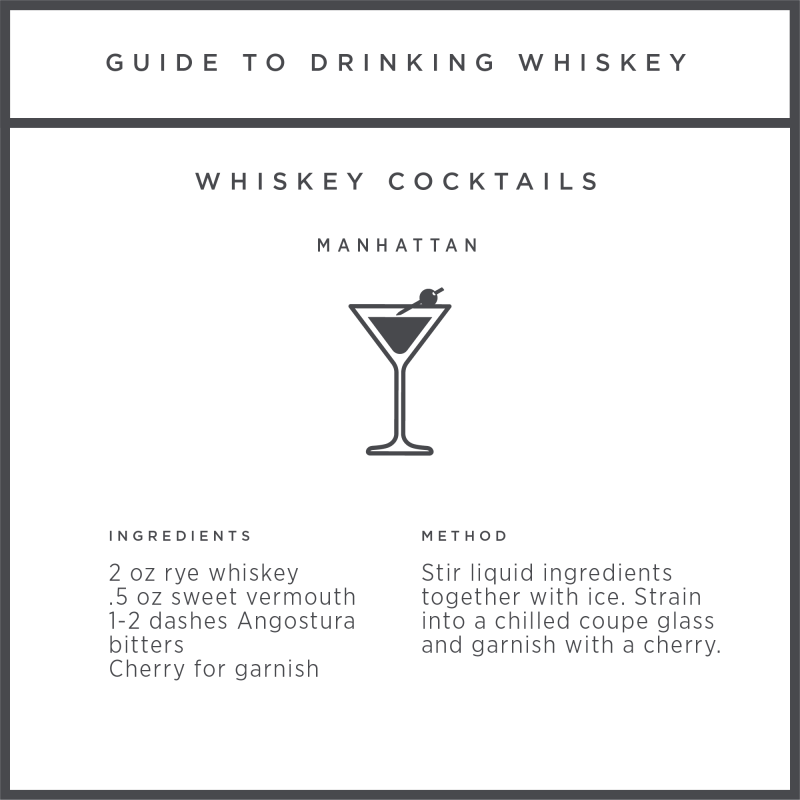
Ingredients
- 2 ounces rye whiskey
- 1/2 ounce sweet vermouth
- 1-2 dashes Angostura bitters
- Cherry for garnish
Method
- Stir liquid ingredients together with ice.
- Strain into a chilled coupe glass and garnish with a cherry.
Whiskey mixers
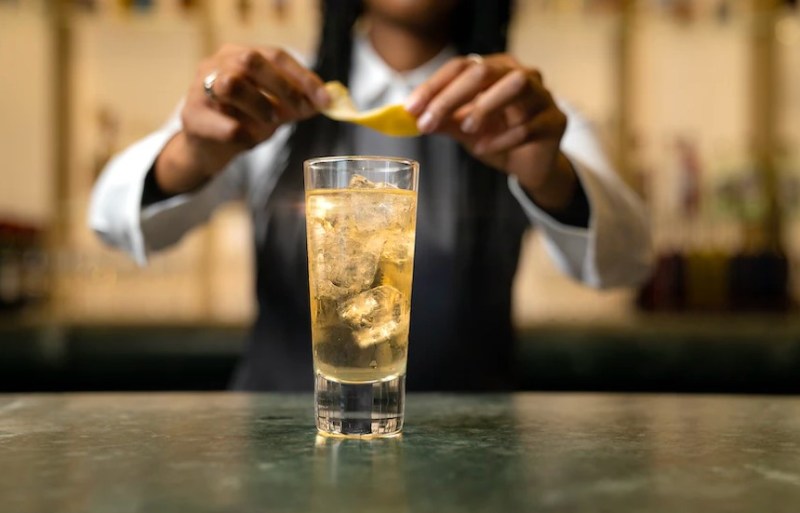
While some whiskey purists may scream “NO,” whiskey can also be enjoyed with just a mixer, generally some kind of carbonated nonalcoholic beverage. According to the Johnnie Walker website, “Combining Scotch with a mixer is a good way to ease yourself into the world of whisky, without compromising on flavor.” Since Johnnie Walker is one of the most popular Scotch brands in the world, it’s safe to say they know whisky (and yes, we used the proper Scotch spelling).
Johnnie Walker suggests trying a highball cocktail. The recipe is simple, fill a tall glass with ice, add the whiskey (or whisky), and top with a mixer. You can use just about anything from ginger ale to soda water and even colas and sweet tea as a good mixer for a highball — it’s really up to you. Use what you enjoy and ignore the purists.
Whiskey glassware
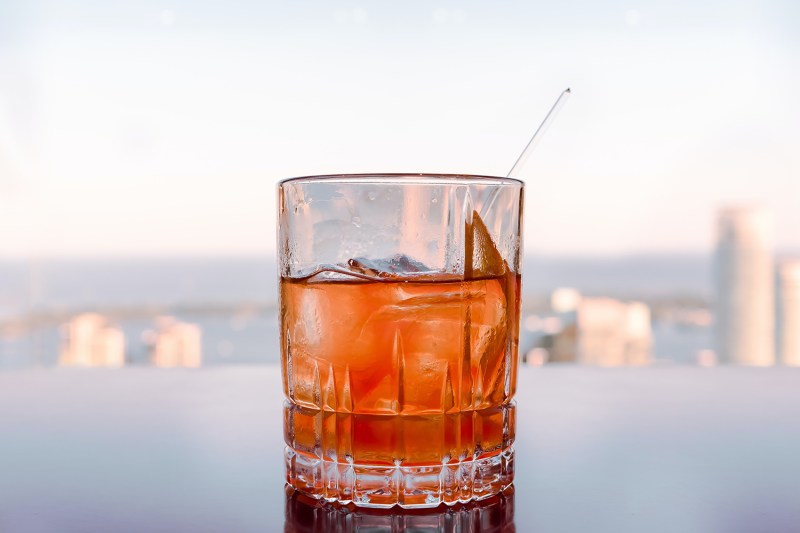
Similar to wine or beer, there’s special glassware designed specifically for drinking whiskey. If you’re enjoying it neat, try to use a tulip-shaped glass or a small snifter of some kind. The shape allows you to better appreciate the fragrance of the spirit. When making up whiskey cocktails, it pays to have a few standard glass shapes in your bar drawer. We suggest an Old Fashioned glass, a martini glass, a highball glass, and a coupe glass. And get at least two of each, as you’ll likely be imbibing with a friend.
Ultimately, you’ll find what works for you, so take these parting wise words about whiskey from Tardie to heart: “Experiment and find what’s right for you. Don’t let anyone tell you how to enjoy it.”
Bottom line

If you read through this whole article, you can see a lot of things go into whiskey tasting, from choosing the whiskey itself, the glassware, whether you plan to drink it neat, on the rocks, or mixed into a cocktail, and various other intricacies.
Above all else, there are two things to remember: Don’t get overwhelmed and do what makes you happy. Don’t get too invested in what others think you should do. If you like to drink your whiskey neat in a Glencairn glass. Go ahead. If you prefer, drink it in a pint glass with ice and cola. You do you.




